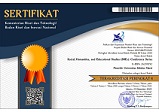Body Safety and Cultural Adaptation on Preventing Child Sexual Abuse: A Literature Review of Children's Stories
Abstract
In the last two decades in Egypt, there have been several national initiatives to face child sexual abuse; however, sexual abuse rates are still high. Stories can teach sensitive messages in a friendly and safe way to children. A child develops through stories, skills in simulation, and observation, and realizes that they are not alone; there are others like them. The purpose of this study is to review English and Arabic children's stories to define the extent to which they incorporate Islamic culture by analyzing body safety education criteria and cultural adaptation themes. This study conducted a literature review of eight children's stories that address body safety education. To analyze, I generate a new tool, the Culturally Adapted Body Safety Framework (CABSF), which was developed to assess content based on two categories: firstly, 8 criteria of body safety education that include body autonomy, personal boundaries, trusted adults, help-seeking, emotional literacy, empowering messages, anatomically correct language of private parts, and safe vs. unsafe touch. Secondly, Cultural Adaptation incorporates five themes that contain engaging visual narratives, real-world stories, awareness of sexual harassment, Islamic culture, and language. The results indicate that the eight stories lacked Islamic values and narrative elements of a story, but rather served as speeches or advice. Awareness of sexual harassment is implicit, not explicit. This study asserts the tailoring of child sexual abuse prevention stories that are culturally adapted to Egyptian and Muslim cultures.
Keywords
Full Text:
PDFRefbacks
- There are currently no refbacks.




